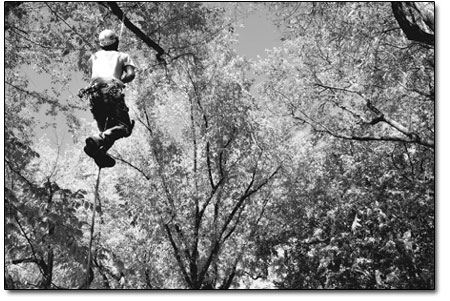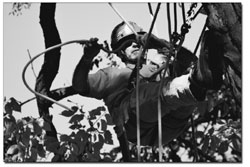| ||||
Out on a limb
by Michelle Duregger There is a band of three modern-day woodsmen who roam Southwest Colorado with ropes and harnesses, pruning pretentious pines, relieving communities of hazardous trees and rescuing distressed pets. These “tree ninjas” – Tom Eskew, O Ryan Gassaway and Christ Chaput – keep their skills honed through a little healthy tree-climbing competition. Of the three local arborists, Eskew has the most equipment, accumulated from 11 years of running his own show at Heartwood West Tree Service. “Here’s another sweet tool,” he says as he slides a super-sized slingshot, “The Big Shot,” out of his truck toolbox. “It’s deadly accurate for setting ropes.” Gassaway disagrees. “It’s for cheaters,” he insists. See, Gassaway and Chaput do tree work solely by climbing and groundwork; Eskew has a truck with a lift bucket for more heavy-duty jobs. Gassaway says he prefers the intimate contact that comes from physically climbing out on each limb, enjoying the peace without the rattle of a truck motor. But Eskew insists he uses motorized assistance only when necessary. “At first I wasn’t going to get a truck,” he admits. “People don’t understand what you can do climbing a tree. You don’t need a lot of gear, just a rope – you could make a rope harness if you had to.” With a hand saw strapped to his calf (ninja style), Gassaway shimmies up two dangling ropes. Displaying the “secured footlock” skills needed to get up most trees using a Prussik knot, he resembles a giant inchworm working its way up a dangling thread of silk. A Prussik allows a climber to ascend a rope but arrests any downward slide. Eskew displays another method, also using a Prussik, muscling his way up the tree next to Gassaway. The two sling ropes from limb to limb, creating a simple web that allows them to traverse the crown of the 40-foot locust tree like a couple of spiders. It looks unnaturally easy. Gassaway has been climbing trees since he was young and brings a unique perspective to the trio. “I grew up a tree-hugger,” he says. “It took me a while to get over cutting them.” Gassaway studied forestry in Ohio but eventually found exploiting trees to be distasteful. “It’s more satisfying to work for people who have first names for the trees in their yard,” he says. “The trees are part of the family.” Five years ago, Gassaway got his first job with Animas Valley Arborists and began his own gig this year – Woodsong Tree Care. Eskew grew up working with an arborist in his hometown of Charlotte, N.C. When he later moved to Durango, he also worked with Animas Valley Arborists before striking out on his own in 1996. Chaput is currently stationed in Telluride but has worked for companies in Durango prior to starting his own business in 2000.
These three tree-climbing comrades, each certified through the International Society of Arboriculture, recently formed a loose knit co-op called the West Slope Arborist Cooperative, fondly nicknamed “WeSlac.” Each of the guys involved in WeSlac falls into his own niche. Gassaway is deadly accurate with his throw line and is a fast, smooth climber. Eskew has the equipment hookup. Chaput has connections in Telluride and a growing set of skills. Keeping these skills sharp is essential for business and for the safety of tree climber and client. To help brush up on these skills, these tree ninjas joined 26 other professional arborists from Colorado and New Mexico – complete with goggles, helmets, harnesses and mad tree-climbing skills – in Boulder on Sept. 28-29. They were drawn by a weekend conference and competition hosted by the International Society of Arboriculture. As people at the Boulder Farmer’s Market looked on in awe, the 26 men ascended 50- to 90-foot trees next to the central park. With Prussiks and a mixture of heavy duty tree climbing harnesses, they presented bystanders a curious spectacle. Though women have competed before, no female contestants made the 2007 Boulder event. The 16,000-member society holds competitions around the world. As part of the Rocky Mountain Chapter, the West Slope crew brought some local spirit to Boulder. With Ska Brewing as their official sponsor, they gave Colorado’s arborists a run for their money with Gassaway placing third overall and Eskew nabbing 13th. However, “O is the one to watch,” Eskew boasts. Gassaway’s skill was evident as he out-tossed Eskew in a throw line demonstration, forcing Eskew to pull out the Big Shot. Arborists work in a world where a dropped tool can be dangerous, a misstep fatal and a slipped cuss word taboo. “If you fall, you could break your back – the ropes are static, not as stretchy as climbing ropes,” says Eskew. Thus, the competitions held by the ISA help keep safety practices and skills sharp. “Watching other people climb is the most valuable aspect of the competition,” explains Gassaway, adding that learning new approaches and techniques from Front Range Crews has been priceless. In each competition, there are six categories, and each event hones a unique skill set. The Belayed Speed Climb (in which Gassaway nabbed first this year) is an all out-race to the top of the tree secured by a belayer and a rope pulley. The Secured Footlock event involves two climbing ropes, secured to a tree limb, on which a climber, using a Prussik, shimmies his way up. During the Work Climb the competitors start from a fixed line at the center of the tree and in five minutes or less must complete five work-related tasks, such as tossing a limb safely while yelling “stand clear” and walking a limb without setting off a buzzer affixed to it. Then there’s the Throw Line event, where arborists must toss a thin cord weighted with bag of lead pellets. The object is to neatly drape the line through one of six targets in the tree. “Try doing that with 200 people watching you,” says Eskew. Chaput wasn’t so phased, snagging third place in this year’s Throw Line. The last event is the Aerial Rescue, which entails retrieving a 150-pound-dummy from the treetops while judges scrutinize every step. Penalties during the competition are given for allowing slack in the ropes, swinging uncontrollably, handling the “casualty” in a rough manner, not communicating with the “casualty,” or even failing to rehang a pole pruner properly. Disqualification results if any tool is dropped, among other industry faux pas. The overall winners go on to compete in the “Master Challenge,” in which the arborist must throw and set his own line and complete a work climb including a pre-climb assessment of equipment and hazards. Gassaway walked away from this event with third. The ISA competition started about 30 years ago as a way for arborists to “blow off steam at the end of the busy season,” explains Eskew, and the competition has been going strong ever since. This is Eskew’s fifth year competing; Gassaway has competed about three years; and Chaput, who held a long time curiosity about the event, finally dug in this year. Eskew hopes to convince the ISA Rocky Mountain Board to hold the next competition in Durango, possibly at Fassbinder Park. Glancing around the park in approval Eskew explains, “It’s way nicer than the one in Boulder. In Fassbinder there is one big maple that would be perfect for a work climb.” But for Durango’s tree ninjas, competition is just the icing on the cake. “I’m grateful every day that I get paid to climb people’s trees,” says Gassaway. “It’s been my first and only job,” Eskew adds, and as he dons his black, skull-print bandanna and straps on his tree-climbing harness, the stoke is still there. •
|
In this week's issue...
- September 11, 2025
- Back on top
After harrowing flying accident, local highliner steps back out with renewed mission
- September 11, 2025
- New order
Rule change for Land and Water Conservation Fund raises alarms
- September 4, 2025
- Armed with knowledge
Local community organizers work to ensure immigrant neighbors know their rights



